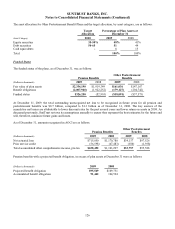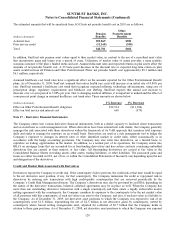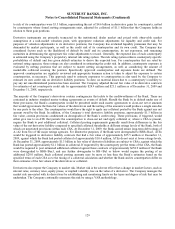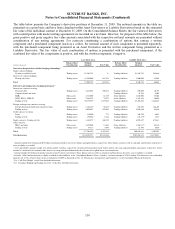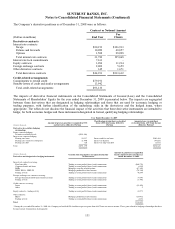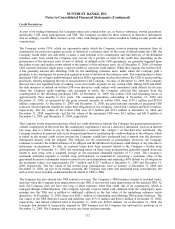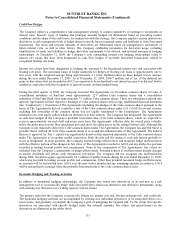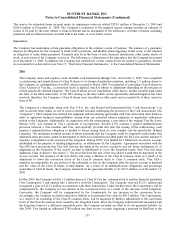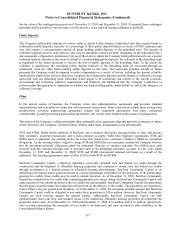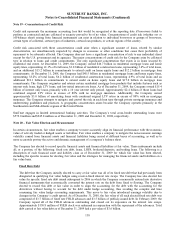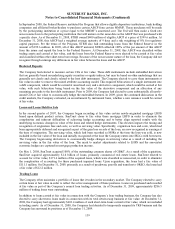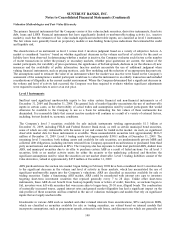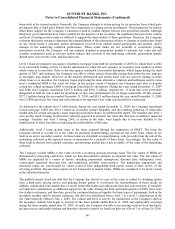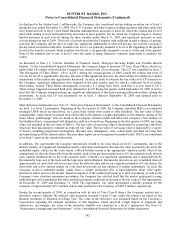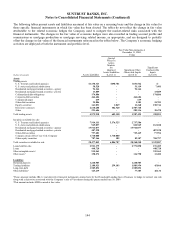SunTrust 2009 Annual Report Download - page 150
Download and view the complete annual report
Please find page 150 of the 2009 SunTrust annual report below. You can navigate through the pages in the report by either clicking on the pages listed below, or by using the keyword search tool below to find specific information within the annual report.SUNTRUST BANKS, INC.
Notes to Consolidated Financial Statements (Continued)
• The Company utilizes interest rate derivatives to mitigate exposures from various instruments.
OThe Company is subject to interest rate risk on its fixed rate debt. As market interest rates move, a
portion of the fair value of the Company’s debt is affected. To protect against this risk on certain
debt issuances that the Company has elected to carry at fair value, the Company has entered into pay
variable-receive fixed interest rate swaps (in addition to entering into certain non-derivative
instruments on a macro basis) that decrease in value in a rising rate environment and increase in
value in a declining rate environment.
OThe Company is exposed to interest rate risk associated with MSRs, which the Company hedges
with a combination of derivatives, including MBS forward and option contracts, and interest rate
swap and swaption contracts.
OThe Company enters into MBS forward and option contracts, interest rate swap and swaption
contracts, futures contracts, and eurodollar options to mitigate interest rate risk associated with
IRLCs, mortgage LHFS, and mortgage loans held for investment reported at fair value.
• The Company is exposed to foreign exchange rate risk associated with certain senior notes denominated in euros
and pound sterling. This risk is economically hedged by entering into cross currency swaps, which receive either
euros or pound sterling and pay U.S. dollars. Interest expense on the Consolidated Statements of Income/(Loss)
reflects only the contractual interest rate on the debt based on the average spot exchange rate during the applicable
period, while fair value changes on the derivatives and valuation adjustments on the debt are both recorded within
trading account profits and commissions.
• The Company enters into CDS to hedge credit risk associated with certain loans held within its Corporate and
Investment Banking and Wealth and Investment Management lines of business. Trading activity, in the tables
above, primarily includes interest rate swaps, equity derivatives, CDS, futures, options and foreign currency
contracts. These derivatives are entered into in a dealer capacity to facilitate client transactions or are utilized as a
risk management tool by the Company as an end user in certain macro-hedging strategies. The macro-hedging
strategies are focused on managing the Company’s overall interest rate risk exposure that is not otherwise hedged
by derivatives or in connection with specific hedges and, therefore, the Company does not specifically associate
individual derivatives with specific assets or liabilities.
Note 18 – Reinsurance Arrangements and Guarantees
Reinsurance
The Company provides mortgage reinsurance on certain mortgage loans through contracts with several primary mortgage
insurance companies. Under these contracts, the Company provides aggregate excess loss coverage in a mezzanine layer in
exchange for a portion of the pool’s mortgage insurance premium. As of December 31, 2009, approximately $15.1 billion of
mortgage loans were covered by such mortgage reinsurance contracts. The reinsurance contracts are intended to place limits
on the Company’s maximum exposure to losses by defining the loss amounts ceded to the Company as well as by
establishing trust accounts for each contract. The trust accounts, which are comprised of funds contributed by the Company
plus premiums earned under the reinsurance contracts, are maintained to fund claims made under the reinsurance contracts. If
claims exceed funds held in the trust accounts, the Company does not intend to make additional contributions beyond future
premiums earned under the existing contracts.
At December 31, 2009, the total loss exposure ceded to the Company was approximately $645.0 million; however, the
maximum amount of loss exposure based on funds held in each separate trust account, including net premiums due to the
trust accounts, was limited to $289.0 million. Of this amount, $285.0 million of losses have been reserved for as of
December 31, 2009, reducing the Company’s net remaining loss exposure to $4.0 million. Future reported losses may exceed
$4.0 million since future premium income will increase the amount of funds held in the trust; however future cash losses, net
of premium income, are not expected to exceed $4.0 million. The amount of future premium income is limited to the
population of loans currently outstanding since additional loans are not being added to the reinsurance contracts; future
premium income could be further curtailed to the extent the Company agrees to relinquish control of individual trusts to the
mortgage insurance companies. Premium income, which totaled $47.6 million, $58.8 million and $37.7 million for the each
of the years ended December 31, 2009, 2008, and 2007, respectively, are reported as part of noninterest income. The related
provision for losses, which totaled $115.0 million and $180.0 million and $0.2 million for each of the years ended
December 31, 2009, 2008, and 2007, respectively, is reported as part of noninterest expense.
134




